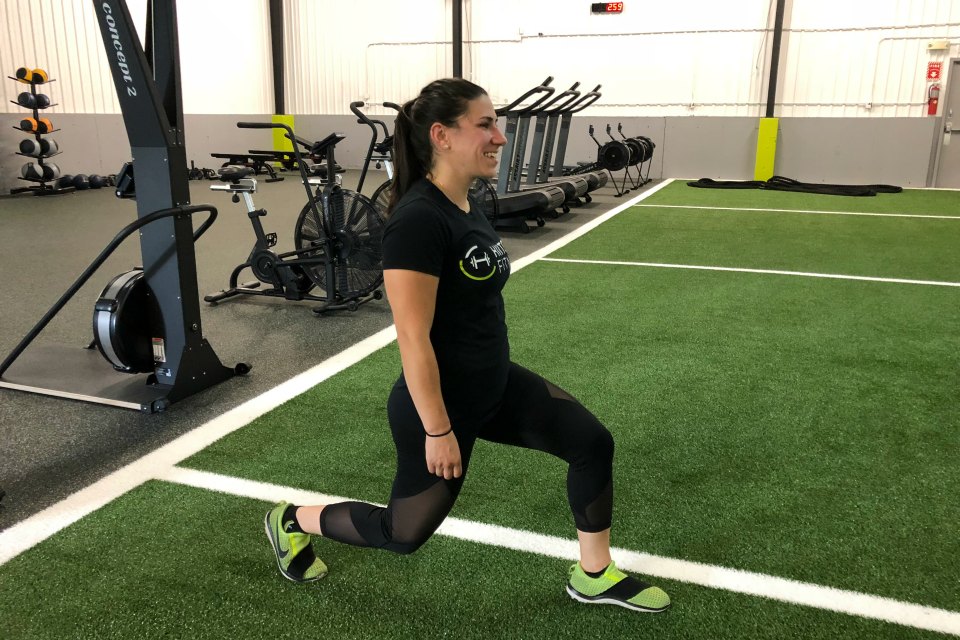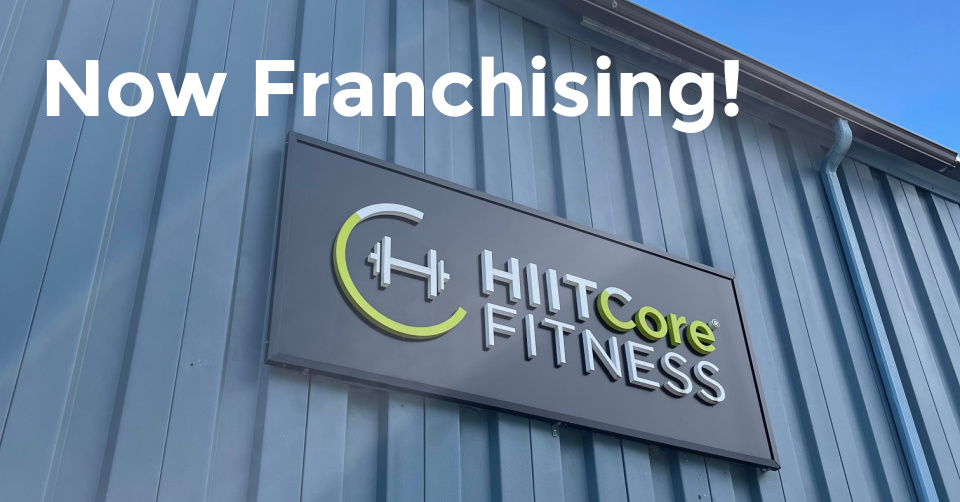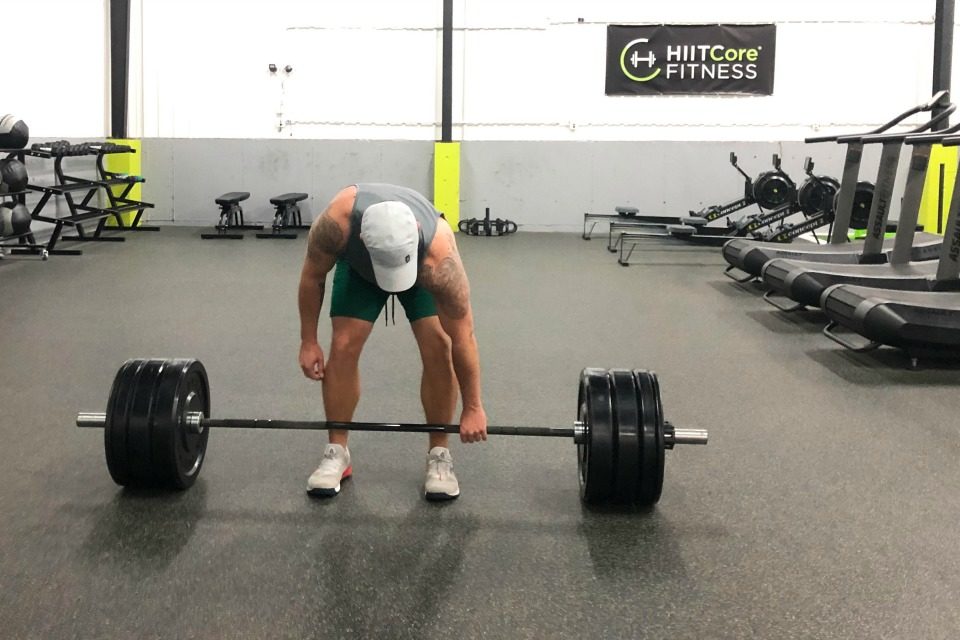- HIITCore Fitness | Braintree & Burlington, MA
- (781) 780-5577
- info@hiitcorefitness.com

Variations of The Lunge Explained
By Alyssa Mazzella, BS, CPT
There are many different variations of lunges that can be performed. Depending on which lunge exercised, the lunge may target one muscle group more heavily than another, however overall lunges mostly target the quadriceps (thighs), glutes (butt), and core. They are also heavily dependent upon hip and hamstring flexibility. Lunges are extremely effective in strengthening those muscles as well improving cardiovascular health.
Static Lunges
Static lunges (also known as stationary split squats) are taken from a split stance where one foot is in front of the other.
How To Execute:
Keeping the chest and core upright, lower the back knee straight down to the ground while watching the angle of the front knee. Aiming to keep both knees at a 90-degree angle, the front knee should not track past the toe of the front foot. Once at the bottom half of the lunge, press up from the toes of the back foot and the heel of the front foot, to return to the starting position. Make sure to always keep the chest and torso upright.
Step Back Lunges
Step back lunges focus on a controlled reverse deceleration and a forward acceleration of the moving leg. It is a lower impact lunge that is moving the body up and down and not through a space. This type of lunge puts a larger emphasis on the glutes. The step back lunge focuses on the lowering down of the back leg so that the knee does not go crashing into the ground and the control of the stationary leg. Gravity will naturally push the leg down, so potentially one can overload the leg with a heavier weight and will still be able to step back into that lunge position without stressing the joints.
How To Execute:
Similar to the static lunge, keep the chest and torso upright at all times. Starting in an upright position with both feet next to each other step back with one leg, lowering the toe and knee down to the ground. Contract the core and focus on keeping the stationary leg strong.
Step Forward Lunges
Step forward lunges focus more on the forward deceleration and a reverse acceleration of the stepping leg. The quadriceps are emphasized more in the step forward lunge. These lunges mimic walking because the body is moving through a space instead of remaining stationary. The acceleration of the stepping leg is used on the pushing back out of the lunge stance, against gravity into the standing upright position.
How To Execute:
Starting in an upright position with both feet next to each other step one leg forward. While lowering the toe and knee of the back leg down to the ground, focus on controlling the speed of the moving leg. Lead with the heel of the moving leg and watch to make sure the knee of the moving leg doesn’t track over the toe. Contract the core and press back to return to the initial standing stance.
Walking Lunges
Walking lunges are more of a plyometric version of a lunge that combines the forward acceleration of the step back lunge with the forward deceleration of the step forward lunge.
How To Execute:
For a forward walking lunge, step forward as if stepping into the forward lunge leading with that foot and lowering the back knee down. Once kneeling on the ground, push off of the back toe and take a long step forward repeating each step.
Reverse walking lunges are performed in a similar motion accepted going in reverse fashion. Reverse walking lunges focus on the reverse deceleration of the step back lunge with the reverse acceleration of the step forward lunge.
Lateral Lunges
Lateral lunges (also known as side lunges) focus more on lateral acceleration of the abductors and the deceleration of the adductors.
How To Execute:
Start with the legs upright together. Step out to the side, in line with the stationary leg, and sit the moving hip back. While sitting the lunging leg back, make sure that the hip stays in line with the rest of the body. The stationary leg will remain unbent even as the depth of the lunge increases.
Modified Lunges
Any of these lunges can be progressed in difficulty by adding a weight or an external resistance to the exercise, adding a rotation or jumping. Depending on where a weight is located compared to the midline of the body and if the weight is evenly held or not, can change the difficulty of the exercise. Holding a weight unevenly and rotating will increase the activation of the abdominal muscles.
It is always important to have proper form before increasing the difficulty of a lunge. Don’t fall into the mistake of leaning forward (weaker core) or bringing the knee over the toe. Both errors can create knee and hip strain and/or pain. When performing any lunge, keep weight in the heel of the front foot, keep the knee in line with the heel, and the upper body as upright as possible. Lunges can also be modified in difficulty to become easier to achieve proper form. Try holding onto an external object such as a pole, wall, or chair in order to have the knee reach a lower depth.
Stretching
Stretching and getting an appropriate warm up is also important to perform a proper lunge. The hip flexors are used in the raising up of the leg or moving the knee up toward the chest. During a lunge, the hip on the back leg is in a stretched position. If the hip muscles have become shortened and tightened due to prolonged sitting or activities that keep the hips in a contracted position for an increased amount of time, then the shortening of the hip flexors can lead hip inflexibility. This hip inflexibility can increase injury risk due to over-stretching or straining of the area. The hip flexors will also become recruited if the abdominal area is weak and unable to stabilize the body during a lunge, which in turn will create an excessive forward torso lean.Stretch!
Dynamic stretches before a workout, walking lunges, hip circles, high knees, butt kicks
Static after a workout: pigeon stretch, groin stretch (butterfly), hamstring hold)
Please don’t hesitate to contact us at info@hiitcorefitness.com if you have any questions or need guidance.



